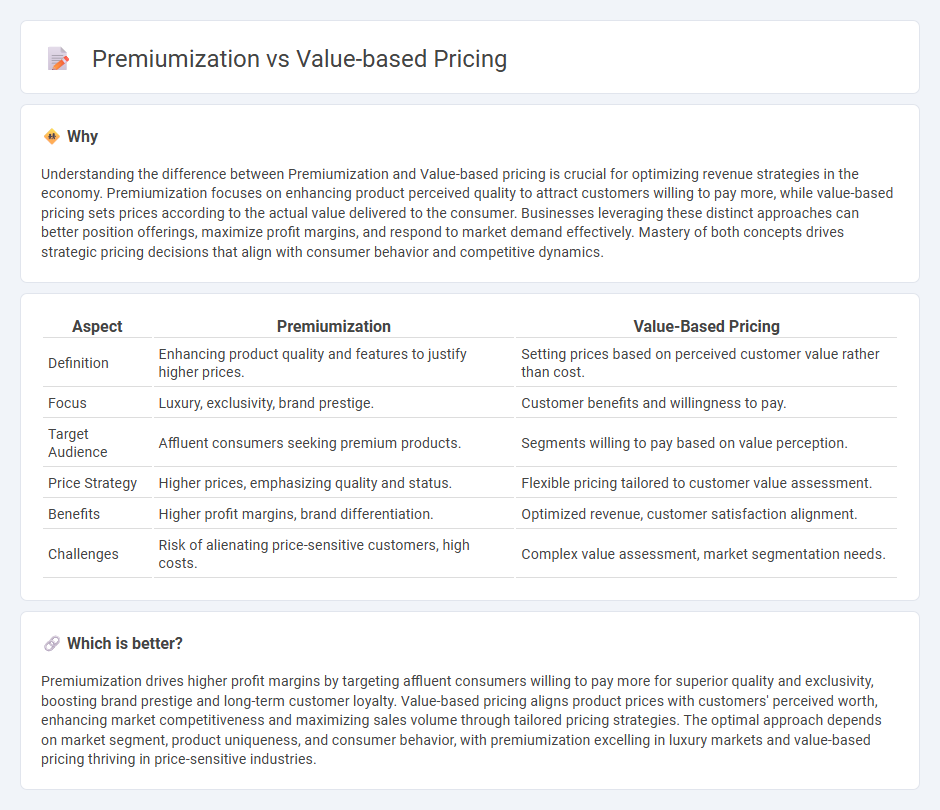
Premiumization emphasizes elevating product quality and brand perception to justify higher prices, targeting discerning consumers seeking exclusivity and superior experiences. Value-based pricing focuses on setting prices according to the perceived value to the customer rather than production costs, ensuring price alignment with market demand and willingness to pay. Explore the strategic differences and market impacts of premiumization and value-based pricing to optimize your pricing models.
Why it is important
Understanding the difference between Premiumization and Value-based pricing is crucial for optimizing revenue strategies in the economy. Premiumization focuses on enhancing product perceived quality to attract customers willing to pay more, while value-based pricing sets prices according to the actual value delivered to the consumer. Businesses leveraging these distinct approaches can better position offerings, maximize profit margins, and respond to market demand effectively. Mastery of both concepts drives strategic pricing decisions that align with consumer behavior and competitive dynamics.
Comparison Table
| Aspect | Premiumization | Value-Based Pricing |
|---|---|---|
| Definition | Enhancing product quality and features to justify higher prices. | Setting prices based on perceived customer value rather than cost. |
| Focus | Luxury, exclusivity, brand prestige. | Customer benefits and willingness to pay. |
| Target Audience | Affluent consumers seeking premium products. | Segments willing to pay based on value perception. |
| Price Strategy | Higher prices, emphasizing quality and status. | Flexible pricing tailored to customer value assessment. |
| Benefits | Higher profit margins, brand differentiation. | Optimized revenue, customer satisfaction alignment. |
| Challenges | Risk of alienating price-sensitive customers, high costs. | Complex value assessment, market segmentation needs. |
Which is better?
Premiumization drives higher profit margins by targeting affluent consumers willing to pay more for superior quality and exclusivity, boosting brand prestige and long-term customer loyalty. Value-based pricing aligns product prices with customers' perceived worth, enhancing market competitiveness and maximizing sales volume through tailored pricing strategies. The optimal approach depends on market segment, product uniqueness, and consumer behavior, with premiumization excelling in luxury markets and value-based pricing thriving in price-sensitive industries.
Connection
Premiumization drives consumers to seek higher quality and exclusive products, allowing brands to implement value-based pricing strategies that reflect perceived worth rather than just cost. Value-based pricing leverages premiumization trends by aligning prices with the emotional and functional benefits customers associate with premium products. This connection boosts profit margins and reinforces brand positioning in competitive markets.
Key Terms
Perceived Value
Value-based pricing centers on setting prices according to the customer's perceived value of a product or service, maximizing willingness to pay rather than cost. Premiumization emphasizes enhancing product quality and brand prestige to elevate perceived value, allowing higher price points in competitive markets. Explore in-depth strategies to leverage perceived value for effective pricing and market positioning.
Market Segmentation
Value-based pricing leverages customer willingness to pay by aligning product prices with perceived value across distinct market segments, enhancing profitability by targeting price-sensitive and value-driven customers effectively. Premiumization concentrates on elevating product quality and exclusivity to attract affluent segments seeking luxury and superior experience, thus commanding higher price points. Explore further to understand how combining these strategies optimizes market segmentation and maximizes revenue potential.
Brand Positioning
Value-based pricing aligns product costs with perceived customer benefits, emphasizing the brand's ability to deliver unique value. Premiumization elevates brand positioning by enhancing product quality, exclusivity, and customer experience to justify higher prices. Explore how integrating these strategies can optimize brand equity and market share.
Source and External Links
The Value-Based Pricing Guide - NetSuite - Value-based pricing is a strategy that sets prices based on customers' perceived value of a product or service, rather than production costs or competitors' prices
Value-Based Pricing - Definition, Example, Use - This approach adjusts prices according to how much value customers believe they will receive, often resulting in higher margins for unique, prestigious, or scarce offerings
A Quick Guide to Value-Based Pricing | Pragmatic Institute - Value-based pricing centers the customer in pricing decisions, focusing on the benefits and outcomes the product delivers to the buyer, which can improve profitability and customer loyalty
 dowidth.com
dowidth.com